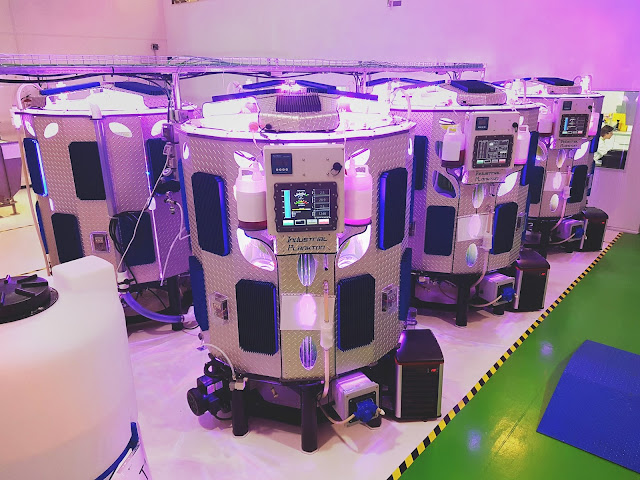by Industrial Plankton, Victoria, Canada
Industrial Plankton is a Canadian company manufacturing live feed equipment focused on biosecurity and automation
The equipment stabilises hatchery yields by increasing the predictability and reliability of on-site live feed production.
To handle biosecurity, the 1000L algae photobioreactor shown here is automatically cleaned and sterilised between culture runs using an internal spray cleaning system and biodegradable detergent.
Air is micron filtered as it enters and exits the sealed tank. Incoming water is micron filtered, then UV sterilised at the point of entry, and a peristaltic pump is used for the automated harvest.
The harvested algae is ideal for feeding shellfish larvae, spat and broodstock, providing greenwater for shrimp and marine finfish hatcheries, or providing feed for zooplankton. The large volumes produced also make a great inoculant for larger tanks or raceways.
Stable culture parameters achievable through automation are also important for biosecurity. Large fluctuations in water temperature, nutrient availability, light levels, and other factors, can cause a portion of the algae culture to die off.
The decomposing cells spike the total organic carbon (TOC), creating an environment that encourages the growth of early colonisers, often pathogenic bacteria like vibrio, the most common and serious pathogen in fish and shellfish marine aquaculture worldwide (Chatterjee, et al. 2012).
Despite efforts to maintain biosecurity in the algae room, pathogenic vibrio species can often be found in algae bag cultures, and even in stock cultures at aquaculture hatcheries (Elston, et al. 2008).
A 20L carboy is an ideal starter culture for these bioreactors, which the control system will scale up to the full tank volume in seven to 10 days.
Once full, harvest is done continuously by overflow, or periodically using the onboard peristaltic pump, with water and nutrients added automatically after each harvest. Alternatively, the whole tank can be harvested as a batch.
The optical density sensor can be used to fine-tune the culture's production.
To boost the productivity, a specially designed tank is used to double the surface area exposed to light, letting cultures grow denser before self-shading limit cell growth.
Read the full article in International Aquafeed magazine, HERE.
Visit the Industrial Plankton website, HERE.
Industrial Plankton is a Canadian company manufacturing live feed equipment focused on biosecurity and automation
The equipment stabilises hatchery yields by increasing the predictability and reliability of on-site live feed production.
To handle biosecurity, the 1000L algae photobioreactor shown here is automatically cleaned and sterilised between culture runs using an internal spray cleaning system and biodegradable detergent.
 |
| Industrial Plankton 1250L PBRs Image credit: Industrial Plankton |
Air is micron filtered as it enters and exits the sealed tank. Incoming water is micron filtered, then UV sterilised at the point of entry, and a peristaltic pump is used for the automated harvest.
The harvested algae is ideal for feeding shellfish larvae, spat and broodstock, providing greenwater for shrimp and marine finfish hatcheries, or providing feed for zooplankton. The large volumes produced also make a great inoculant for larger tanks or raceways.
Stable culture parameters achievable through automation are also important for biosecurity. Large fluctuations in water temperature, nutrient availability, light levels, and other factors, can cause a portion of the algae culture to die off.
The decomposing cells spike the total organic carbon (TOC), creating an environment that encourages the growth of early colonisers, often pathogenic bacteria like vibrio, the most common and serious pathogen in fish and shellfish marine aquaculture worldwide (Chatterjee, et al. 2012).
Despite efforts to maintain biosecurity in the algae room, pathogenic vibrio species can often be found in algae bag cultures, and even in stock cultures at aquaculture hatcheries (Elston, et al. 2008).
A 20L carboy is an ideal starter culture for these bioreactors, which the control system will scale up to the full tank volume in seven to 10 days.
Once full, harvest is done continuously by overflow, or periodically using the onboard peristaltic pump, with water and nutrients added automatically after each harvest. Alternatively, the whole tank can be harvested as a batch.
The optical density sensor can be used to fine-tune the culture's production.
To boost the productivity, a specially designed tank is used to double the surface area exposed to light, letting cultures grow denser before self-shading limit cell growth.
Read the full article in International Aquafeed magazine, HERE.
Visit the Industrial Plankton website, HERE.
The Aquaculturists
This blog is maintained by The Aquaculturists staff and is supported by the
magazine International Aquafeed which is published by Perendale Publishers Ltd
For additional daily news from aquaculture around the world: aquaculture-news